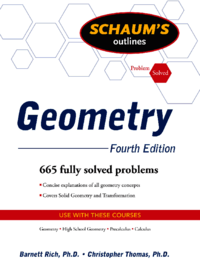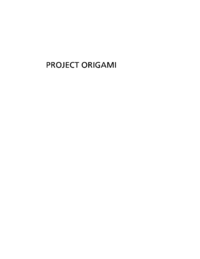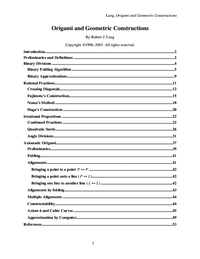Etiqueta "geometria"
Se han encontrado 4 Coincidencias
Geometry
Geometry
148 Visitas | 191 Descargas | 2013-10-02 12:58:32 | alvarojs
The central purpose of this book is to provide maximum help for the student and maximum service for the teacher.

Project origami
origami y geometría
183 Visitas | 198 Descargas | 2013-10-17 13:05:29 | javierd
Este libro contiene un conjunto de ejercicios que vinculan el origami con la geometría, por ejemplo, cómo plegar una parábola.

Origami and geometrics constructions
geometría y origami
133 Visitas | 166 Descargas | 2013-10-17 15:14:31 | javierd
The classical rules of compass-and-straightedge allow a single compass to strike arcs and transfer distances, and a single unmarked straightedge to draw straight lines; the two may not be used in combination (for example, holding the compass against the straightedge to effectively mark the latter). However, there are many variations on the general theme of geometric constructions that include use of marked rules and tools other than compasses for the construction of geometric figures. One of the more interesting variations is the use of a folded sheet of paper for geometric construction. Like compass-and-straightedge constructions, folded-paper constructions are both academically interesting and practically useful—particularly within origami, the art of folding uncut sheets of paper into interesting and beautiful shapes. Modern origami design has shown that it is possible to fold shapes of unbelievable complexity, realism, and beauty from a single uncut square. Origami figures posses an aesthetic beauty that appeals to both the mathematician and the layman. Part of their appeal is the simplicity of the concept: from the simplest of beginnings springs an object of depth, subtlety, and complexity that often can be constructed by a precisely defined sequence of folding steps. However, many origami designs—even quite simple ones—require that one create the initial folds at particular locations on the square: dividing it into thirds or twelfths, for example. While one could always measure and mark these points, there is an aesthetic appeal to creating these key points, known as reference points, purely by folding.

Matemáticas y Origami
geometría y origami
137 Visitas | 153 Descargas | 2013-10-17 15:19:31 | javierd
En el First International Meeting of Origami Science and Technology celebrado el año 1989, el profesor Humiaki Huzita presentó un trabajo en el que se establecían los axiomas de una nueva geometría que él mismo denominó Geometría del Origami y que resuelve problemas irresolubles con regla y compás mediante la geometría clásica como son la trisección del ángulo o la duplicación del cubo. A partir de entonces son muchos los matemáticos que han trabajado sobre dicha geometría obteniéndose importantes resultados que sin embargo son totalmente desconocidos por muchos otros debido quizás a que tiene muy pocos años de existencia. Se pretende con este trabajo dar a conocer los principios básicos de dicha Geometría y plantear otros problemas que relacionan el Origami con la Geometría Computacional y la Teoría de Grafos.
Contribuir
Usted puede contribuir con Libros UCLV, es importante para nosotros su aporte..
Contribuir